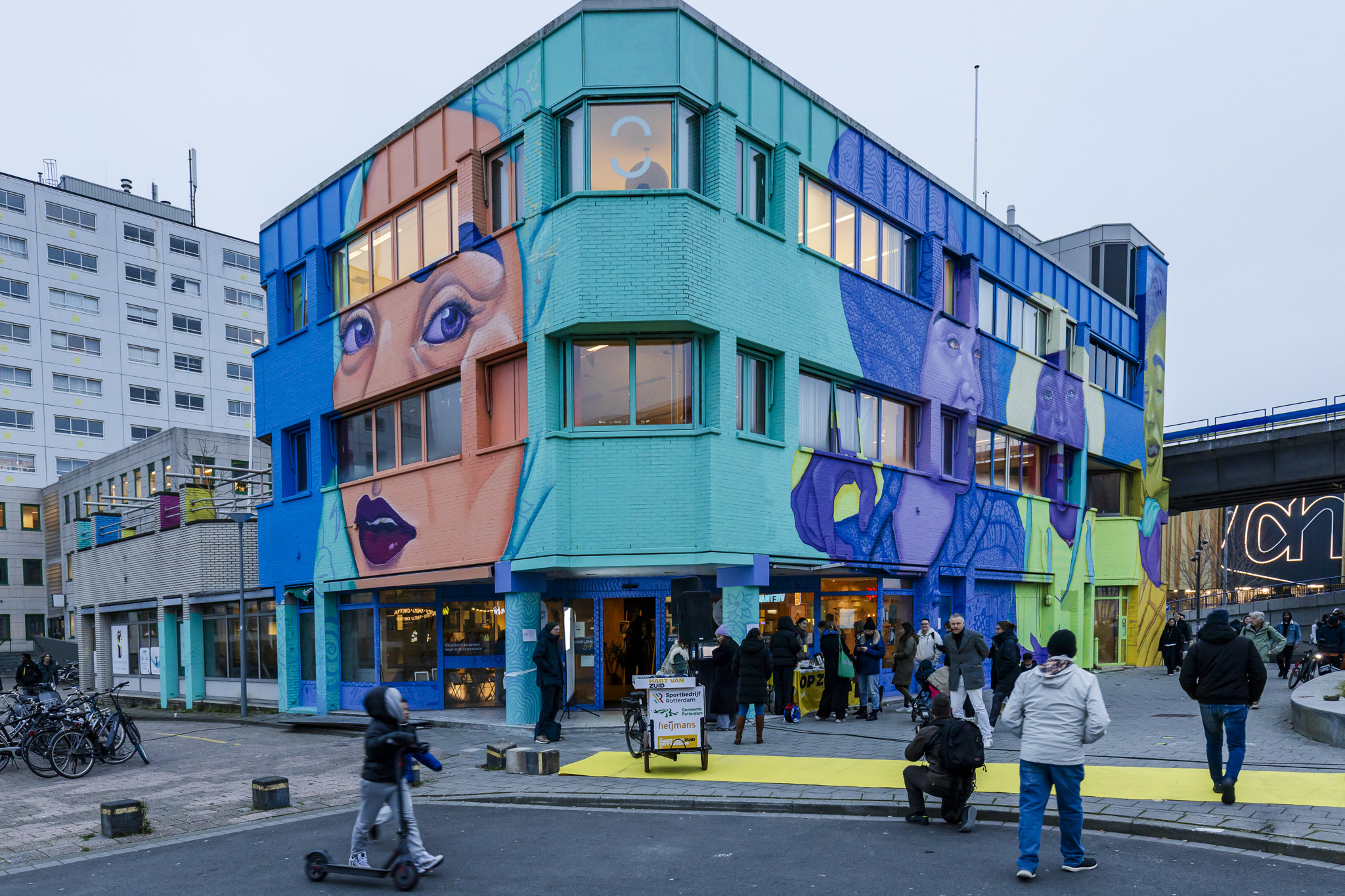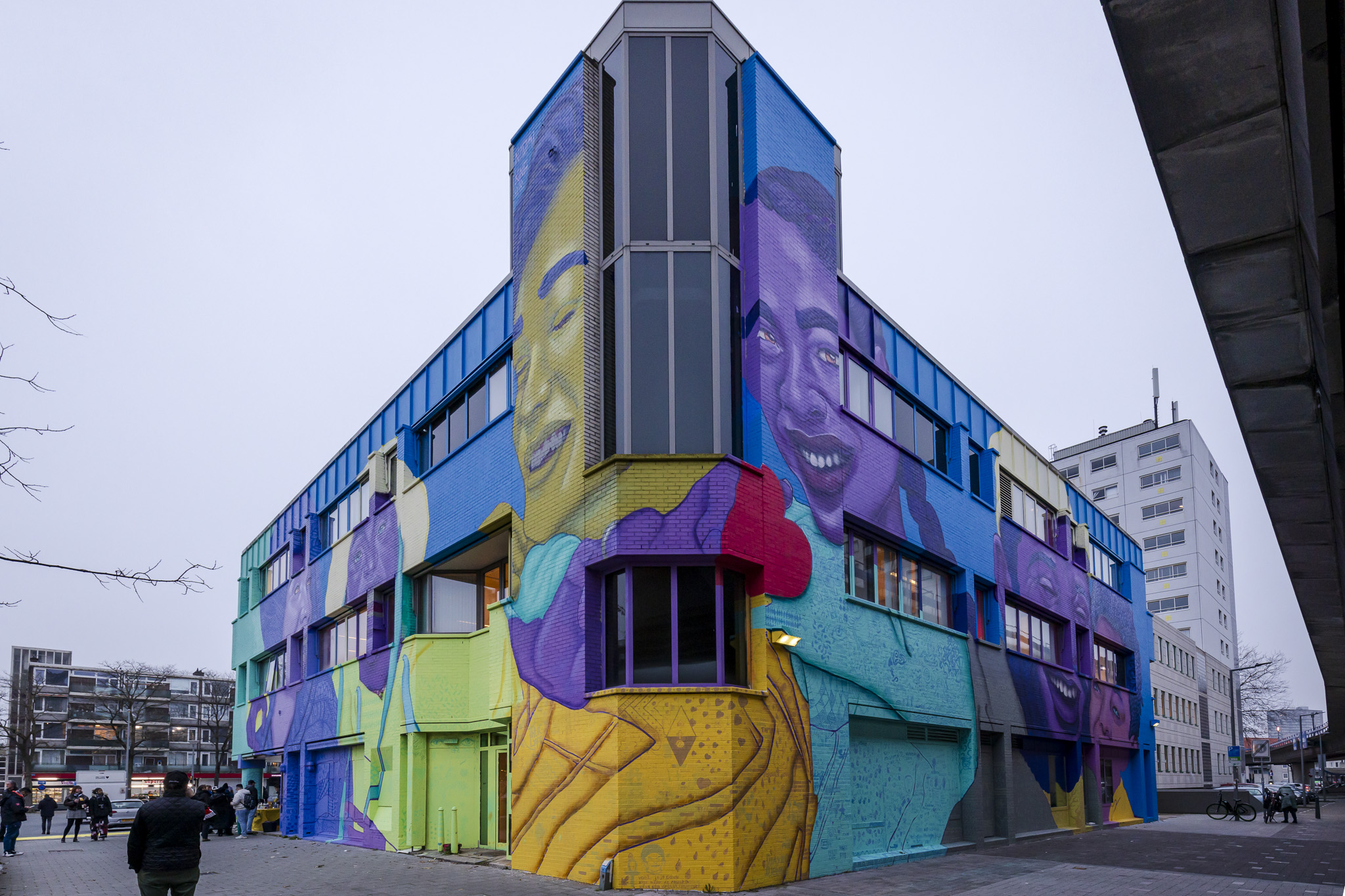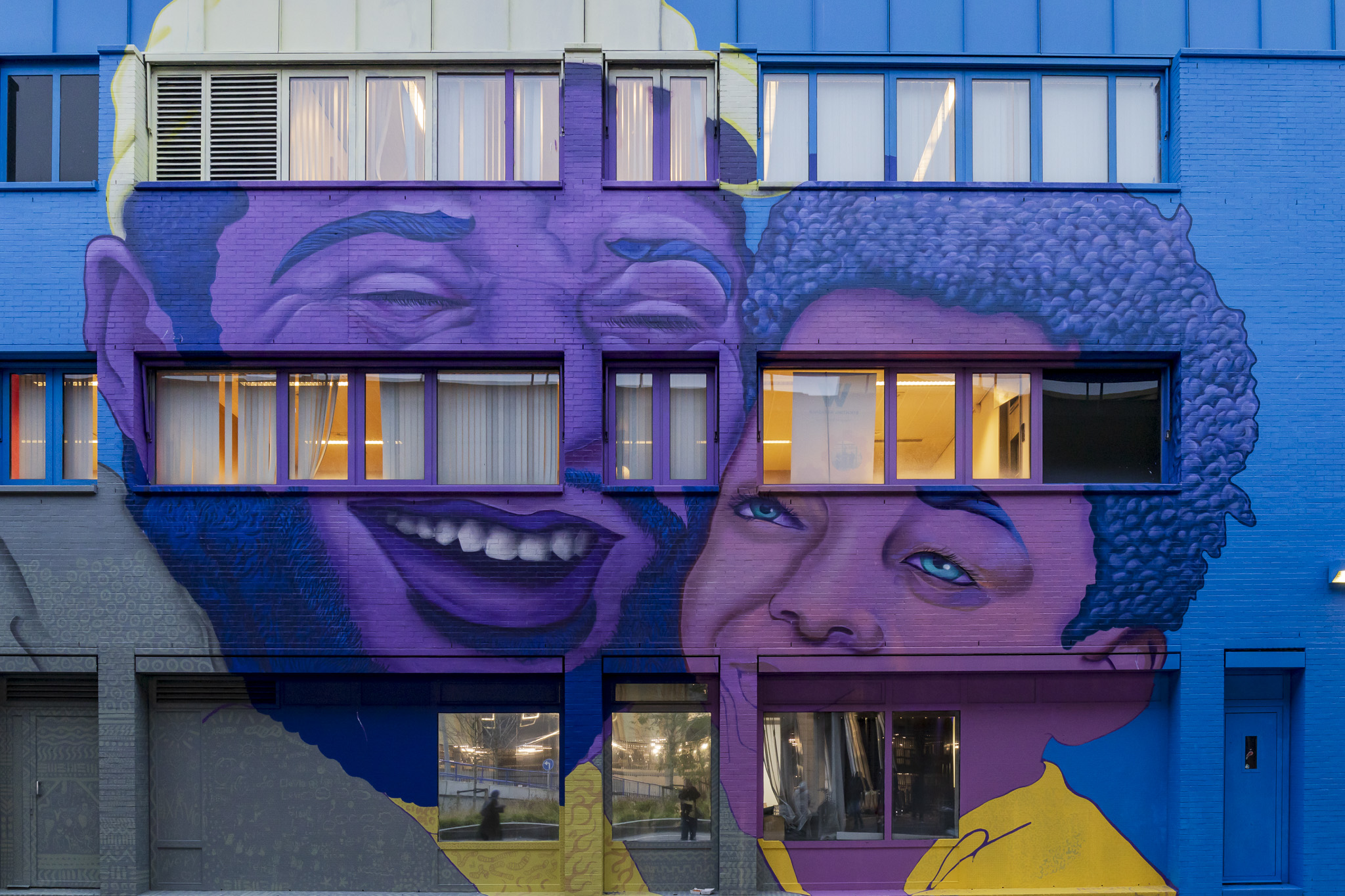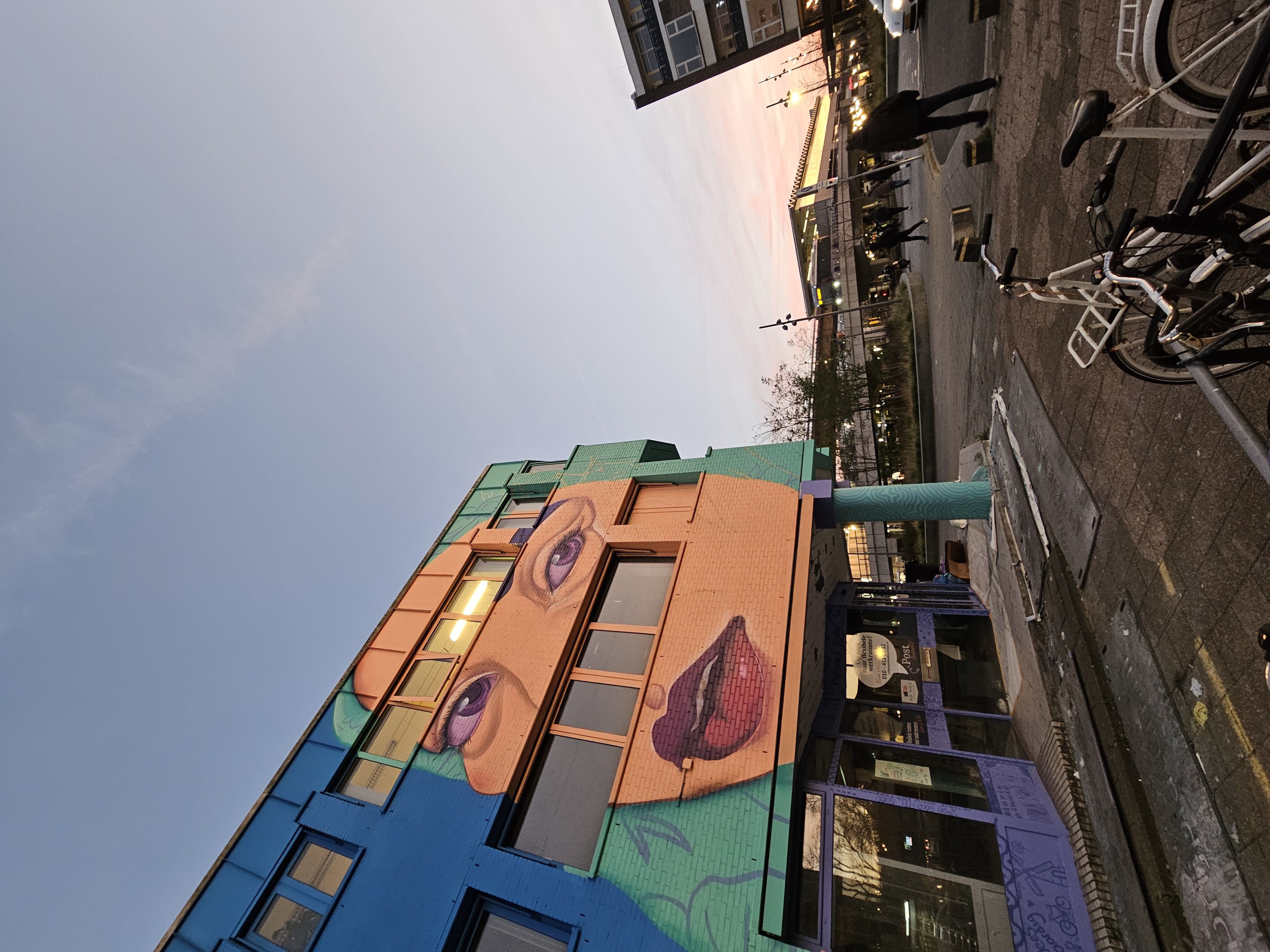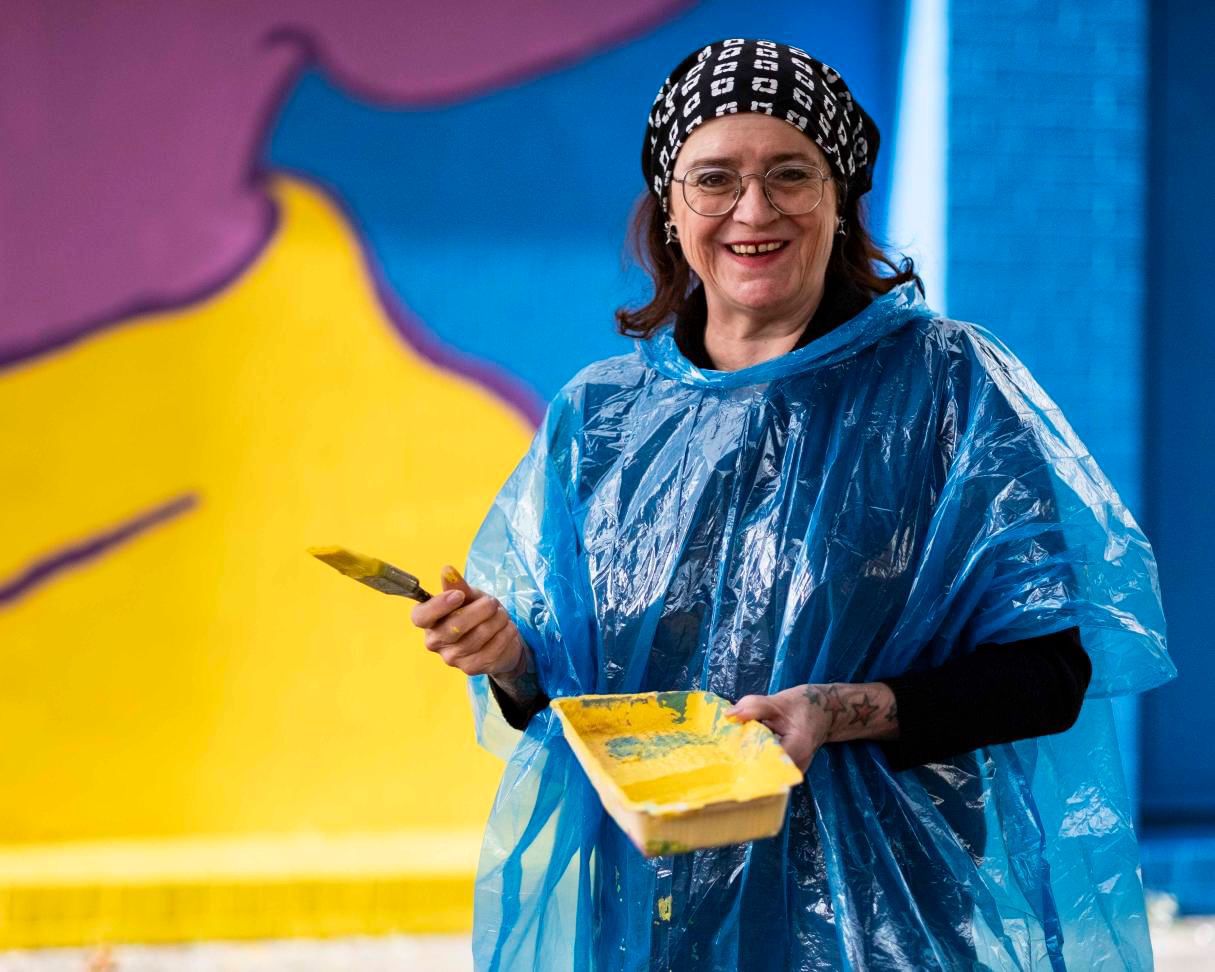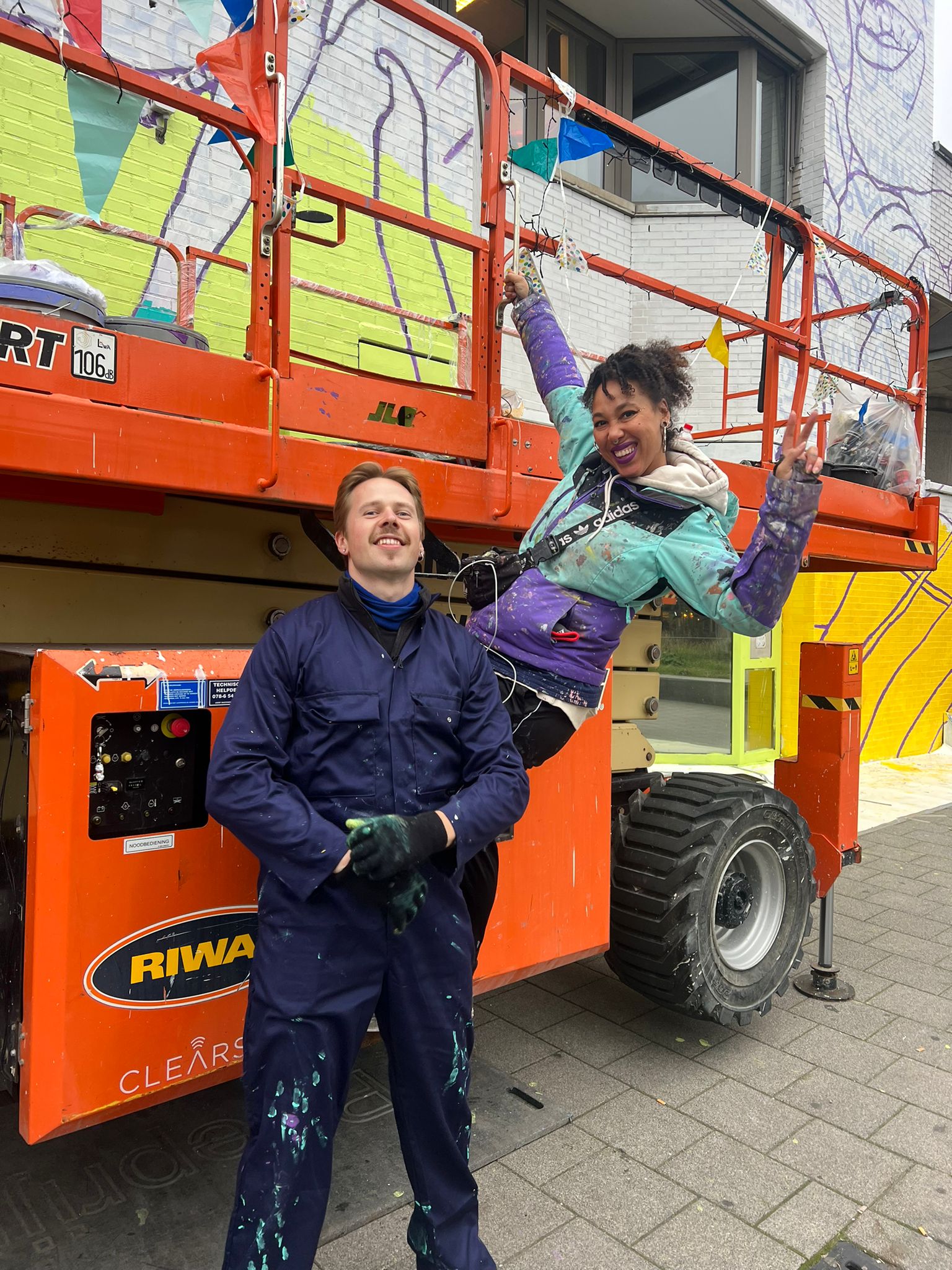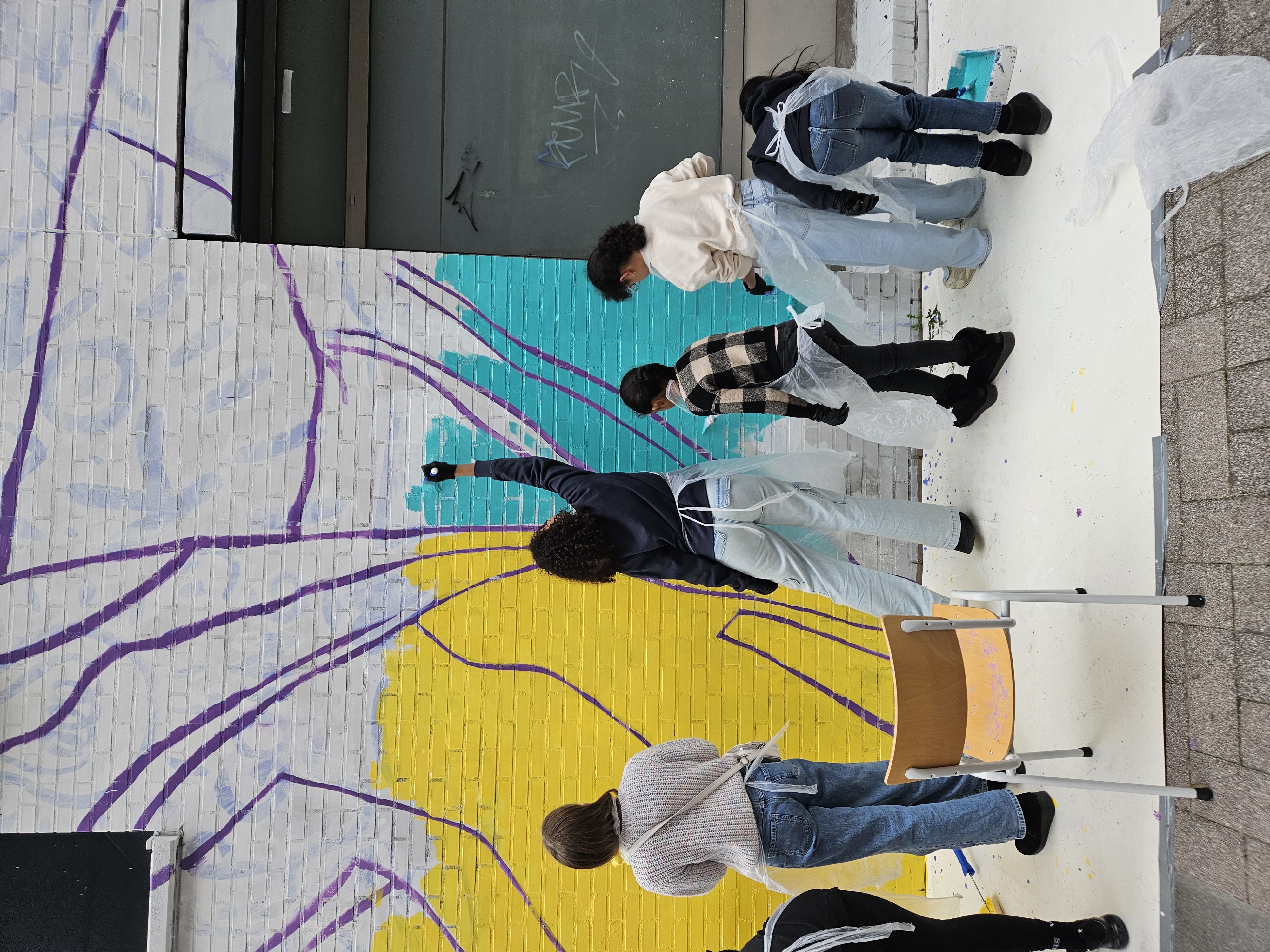Regaining a sense of belonging
Mi Lobi Zuid
{Empty}
Mi Lobi Zuid" is a colorful mural at Zuidplein, Rotterdam, symbolizing local pride. Led by artist Naomi King and Joris Sauerbier, a graduate student of the Urban Leisure & Tourism Lab, over 120 residents and local students joined in to paint, creating a truly participatory artwork. This collaborative effort connected communities and brought color, positivity, and a sense of ownership to the Hart van Zuid area, showcasing the power of collaboration and creativity in transforming public spaces.
Netherlands
Local
Hart van Zuid in Rotterdam South.
Mainly urban
It refers to a physical transformation of the built environment (hard investment)
Yes
2024-12-11
No
No
No
As a representative of an organisation
Overall Aim:Mi Lobi Zuid aimed to foster connection, and belonging in the Hart Van Zuid area. This collaborative project transformed the former ABN AMRO building with a vibrant mural, bringing new life to the urban landscape while strengthening community ties.
Target Group(s):The project engaged the entire Hart van Zuid community, welcoming individuals of all backgrounds (even those without permanent housing), to paint together. It embraced inclusivity, ensuring everyone had the opportunity to contribute.
Specific Objectives: Foster Inclusivity: Involve a diverse group of participants, including those from marginalized communities, in a shared creative process.
Celebrate Local Identity: Reflect the area’s cultural and demographic diversity through a participatory art piece.
Strengthen Community Bonds: Encourage collaboration between residents, students, and local organizations.
Urban Renewal: Enhance the aesthetic and social appeal of Zuidplein through a meaningful and community-driven transformation.
Achieved Outcomes
Mi Lobi Zuid brought together over 370 individuals to paint the mural, including residents, students, and people without a fixed address. This inclusivity fostered a renewed sense of connection and pride. The project celebrated the neighborhood’s vibrancy while creating a more welcoming and inspiring environment at Zuidplein.
Collaboration:The initiative was a collaboration between Inholland’s Urban Leisure & Tourism Lab Rotterdam, Heijmans, and Rabobank. It also served as a graduation project for Joris Sauerbier, who led the effort in partnership with artist Naomi King.
Context and Alignment:Mi Lobi Zuid exemplifies how art can regenerate urban spaces and strengthen social bonds. By linking contemporary creativity with local culture and inclusivity, the project revitalized the area and showcased the power of community-led transformation. It stands as a testament to the potential of collaboration in creating a sense of belonging.
Target Group(s):The project engaged the entire Hart van Zuid community, welcoming individuals of all backgrounds (even those without permanent housing), to paint together. It embraced inclusivity, ensuring everyone had the opportunity to contribute.
Specific Objectives: Foster Inclusivity: Involve a diverse group of participants, including those from marginalized communities, in a shared creative process.
Celebrate Local Identity: Reflect the area’s cultural and demographic diversity through a participatory art piece.
Strengthen Community Bonds: Encourage collaboration between residents, students, and local organizations.
Urban Renewal: Enhance the aesthetic and social appeal of Zuidplein through a meaningful and community-driven transformation.
Achieved Outcomes
Mi Lobi Zuid brought together over 370 individuals to paint the mural, including residents, students, and people without a fixed address. This inclusivity fostered a renewed sense of connection and pride. The project celebrated the neighborhood’s vibrancy while creating a more welcoming and inspiring environment at Zuidplein.
Collaboration:The initiative was a collaboration between Inholland’s Urban Leisure & Tourism Lab Rotterdam, Heijmans, and Rabobank. It also served as a graduation project for Joris Sauerbier, who led the effort in partnership with artist Naomi King.
Context and Alignment:Mi Lobi Zuid exemplifies how art can regenerate urban spaces and strengthen social bonds. By linking contemporary creativity with local culture and inclusivity, the project revitalized the area and showcased the power of community-led transformation. It stands as a testament to the potential of collaboration in creating a sense of belonging.
participation
safety
community-led
connection
art
Key Objectives in Terms of Sustainability
Mi Lobi Zuid integrated social, cultural, and environmental sustainability through its participatory approach. The main objectives were:
Fostering Social Cohesion
The project aimed to strengthen community ties by involving over 370 residents, including those without stable housing, in painting the mural. This inclusive process encouraged mutual understanding, intergenerational exchange, and a sense of belonging.
Enhancing Cultural Sustainability
Mi Lobi Zuid celebrated the diverse identity of Hart van Zuid. By incorporating input from local participants, the mural reflects the area's unique cultural heritage and fosters pride among residents.
Urban and Environmental Sustainability
By transforming a neglected facade, the project improved the visual and social environment of Zuidplein, making it more inviting and safer. The bright colors and welcoming design deter vandalism and promote community care for the space. Additionally, durable, eco-friendly materials were used to ensure the mural's longevity with minimal environmental impact.
Achievements and Exemplary Value
Inclusion as a Core Principle: The open-door policy invited all community members, including vulnerable groups, to contribute, setting a benchmark for inclusive urban projects.
Safety through Design: The use of vibrant colors and community involvement created a sense of ownership, reducing neglect and increasing safety in a sustainable way.
Collaborative Success: Partnerships with Hart van Zuid, Hogeschool Inholland’s Urban Leisure & Tourism Lab Rotterdam, Heijmans, and Rabobank highlight the power of collaboration in achieving sustainable goals.
Exemplary Potential
Mi Lobi Zuid demonstrates how holistic sustainability—social, cultural, and environmental—can transform urban spaces. Its participatory and inclusive approach serves as a replicable model for creating safer, vibrant, and sustainable communities worldwide.
Mi Lobi Zuid integrated social, cultural, and environmental sustainability through its participatory approach. The main objectives were:
Fostering Social Cohesion
The project aimed to strengthen community ties by involving over 370 residents, including those without stable housing, in painting the mural. This inclusive process encouraged mutual understanding, intergenerational exchange, and a sense of belonging.
Enhancing Cultural Sustainability
Mi Lobi Zuid celebrated the diverse identity of Hart van Zuid. By incorporating input from local participants, the mural reflects the area's unique cultural heritage and fosters pride among residents.
Urban and Environmental Sustainability
By transforming a neglected facade, the project improved the visual and social environment of Zuidplein, making it more inviting and safer. The bright colors and welcoming design deter vandalism and promote community care for the space. Additionally, durable, eco-friendly materials were used to ensure the mural's longevity with minimal environmental impact.
Achievements and Exemplary Value
Inclusion as a Core Principle: The open-door policy invited all community members, including vulnerable groups, to contribute, setting a benchmark for inclusive urban projects.
Safety through Design: The use of vibrant colors and community involvement created a sense of ownership, reducing neglect and increasing safety in a sustainable way.
Collaborative Success: Partnerships with Hart van Zuid, Hogeschool Inholland’s Urban Leisure & Tourism Lab Rotterdam, Heijmans, and Rabobank highlight the power of collaboration in achieving sustainable goals.
Exemplary Potential
Mi Lobi Zuid demonstrates how holistic sustainability—social, cultural, and environmental—can transform urban spaces. Its participatory and inclusive approach serves as a replicable model for creating safer, vibrant, and sustainable communities worldwide.
Key Objectives in Terms of Aesthetics and Quality of Experience
Mi Lobi Zuid transformed Zuidplein into a vibrant and meaningful space. The objectives were:
Improving Visual Appeal
The mural replaced a dull facade with a colorful, community-driven design reflecting local stories and aspirations, creating a welcoming and uplifting environment.
Fostering a Sense of Belonging
By actively involving over 370 participants, including vulnerable groups, the project created meaningful experiences that fostered pride and a sense of ownership. This collective effort transformed a functional urban space into a shared, culturally rich landmark.
Cultural and Safety Benefits
Research shows that color improves perceptions of safety, a key focus for Mi Lobi Zuid. Residents reported feeling safer and more positive about the area after the mural’s completion. Additionally, the project encouraged a cleaner and more cared-for environment.
Achievements and Exemplary Value
Aesthetic and Emotional Impact: The bold, vibrant design revitalized the space, celebrating diversity and connecting deeply with the area’s cultural identity.
Community Building: The participatory process fostered a strong sense of belonging and pride among participants, creating lasting emotional connections to the space.
Safety and Cleanliness: The mural not only enhanced visual appeal but also improved the sense of safety and cleanliness, making the space more welcoming.
Enduring Cultural Values: By embedding local stories, diversity, and aspirations into the design, Mi Lobi Zuid integrated new cultural and social values that inspire the community.
Exemplary Potential
Mi Lobi Zuid exemplifies how collaborative design can elevate urban spaces by creating meaningful experiences, fostering cultural and emotional connections, and promoting enduring social values.
Mi Lobi Zuid transformed Zuidplein into a vibrant and meaningful space. The objectives were:
Improving Visual Appeal
The mural replaced a dull facade with a colorful, community-driven design reflecting local stories and aspirations, creating a welcoming and uplifting environment.
Fostering a Sense of Belonging
By actively involving over 370 participants, including vulnerable groups, the project created meaningful experiences that fostered pride and a sense of ownership. This collective effort transformed a functional urban space into a shared, culturally rich landmark.
Cultural and Safety Benefits
Research shows that color improves perceptions of safety, a key focus for Mi Lobi Zuid. Residents reported feeling safer and more positive about the area after the mural’s completion. Additionally, the project encouraged a cleaner and more cared-for environment.
Achievements and Exemplary Value
Aesthetic and Emotional Impact: The bold, vibrant design revitalized the space, celebrating diversity and connecting deeply with the area’s cultural identity.
Community Building: The participatory process fostered a strong sense of belonging and pride among participants, creating lasting emotional connections to the space.
Safety and Cleanliness: The mural not only enhanced visual appeal but also improved the sense of safety and cleanliness, making the space more welcoming.
Enduring Cultural Values: By embedding local stories, diversity, and aspirations into the design, Mi Lobi Zuid integrated new cultural and social values that inspire the community.
Exemplary Potential
Mi Lobi Zuid exemplifies how collaborative design can elevate urban spaces by creating meaningful experiences, fostering cultural and emotional connections, and promoting enduring social values.
Key Objectives in Terms of Inclusion
Mi Lobi Zuid was designed to be an inclusive and accessible project, ensuring that all members of the community could participate, regardless of background or physical ability. The key objectives were:
Accessibility for All
The project was made accessible to everyone, including individuals with mobility issues, such as those in wheelchairs. By ensuring that the mural's creation process was fully inclusive, we encouraged participation from all members of the community. Additionally, materials were provided to protect participants' shoes and clothing from paint, ensuring a comfortable and welcoming experience for all.
Celebrating Diversity
Mi Lobi Zuid reflected the area's diverse cultural and demographic landscape. The mural integrated local stories, traditions, and identities, celebrating both the uniqueness of the community and its shared sense of belonging.
Addressing Spatial Segregation and Isolation
By transforming an underutilized public space into a vibrant, participatory artwork, the project helped bridge social and spatial divides. It encouraged interaction between different social, cultural, and generational groups, fostering connections in an inclusive environment.
Supporting Vulnerable Groups
The project also provided a platform for vulnerable individuals to contribute to the transformation of their neighborhood. Through creative expression, these participants experienced empowerment, increased their sense of belonging, and helped combat social isolation.
Exemplary Value
Mi Lobi Zuid is an exemplary model of inclusive design and governance. It provided a space where everyone, regardless of ability, could participate in creating something beautiful and meaningful. The project celebrated diversity, reduced isolation, and encouraged intergenerational and cross-cultural exchanges, demonstrating how inclusive, accessible projects can strengthen communities.
Mi Lobi Zuid was designed to be an inclusive and accessible project, ensuring that all members of the community could participate, regardless of background or physical ability. The key objectives were:
Accessibility for All
The project was made accessible to everyone, including individuals with mobility issues, such as those in wheelchairs. By ensuring that the mural's creation process was fully inclusive, we encouraged participation from all members of the community. Additionally, materials were provided to protect participants' shoes and clothing from paint, ensuring a comfortable and welcoming experience for all.
Celebrating Diversity
Mi Lobi Zuid reflected the area's diverse cultural and demographic landscape. The mural integrated local stories, traditions, and identities, celebrating both the uniqueness of the community and its shared sense of belonging.
Addressing Spatial Segregation and Isolation
By transforming an underutilized public space into a vibrant, participatory artwork, the project helped bridge social and spatial divides. It encouraged interaction between different social, cultural, and generational groups, fostering connections in an inclusive environment.
Supporting Vulnerable Groups
The project also provided a platform for vulnerable individuals to contribute to the transformation of their neighborhood. Through creative expression, these participants experienced empowerment, increased their sense of belonging, and helped combat social isolation.
Exemplary Value
Mi Lobi Zuid is an exemplary model of inclusive design and governance. It provided a space where everyone, regardless of ability, could participate in creating something beautiful and meaningful. The project celebrated diversity, reduced isolation, and encouraged intergenerational and cross-cultural exchanges, demonstrating how inclusive, accessible projects can strengthen communities.
Mi Lobi Zuid was a deeply participatory project, where local residents were integral in the co-design, decision-making, and implementation phases.
Co-Design and Decision-Making
Through meetings, residents influenced the mural’s themes and design. This participatory approach encouraged a sense of ownership, allowing the community to imprint their collective identity on the public space. Their direct involvement ensured the artwork was not only a physical transformation but also a symbol of shared pride.
Inclusive Participation
The project focused on accessibility, ensuring everyone could participate regardless of their background or physical ability. Efforts were made to include people with mobility challenges and those without permanent housing. Protective materials were provided to ensure participants’ clothing and shoes remained clean during the painting process, removing barriers to involvement.
Empowerment and Social Impact
The community’s active role in transforming their own neighborhood fostered a greater sense of belonging. People from different backgrounds and generations came together, engaging in exchanges that built stronger relationships and addressed social isolation. This process empowered individuals to take pride in their environment, contributing to a renewed sense of community.
Future Vision and Manifest
During the project, citizens shared their visions for future participation and purpose within their community. These discussions were compiled into a manifest, which will guide future initiatives, ensuring relevance and alignment with community needs.
Long-Term Impact
The mural’s completion has created a vibrant, welcoming environment, with feedback indicating increased safety and cohesion. The project sparked dialogue on how public spaces can promote social interaction and strengthen communities.
Co-Design and Decision-Making
Through meetings, residents influenced the mural’s themes and design. This participatory approach encouraged a sense of ownership, allowing the community to imprint their collective identity on the public space. Their direct involvement ensured the artwork was not only a physical transformation but also a symbol of shared pride.
Inclusive Participation
The project focused on accessibility, ensuring everyone could participate regardless of their background or physical ability. Efforts were made to include people with mobility challenges and those without permanent housing. Protective materials were provided to ensure participants’ clothing and shoes remained clean during the painting process, removing barriers to involvement.
Empowerment and Social Impact
The community’s active role in transforming their own neighborhood fostered a greater sense of belonging. People from different backgrounds and generations came together, engaging in exchanges that built stronger relationships and addressed social isolation. This process empowered individuals to take pride in their environment, contributing to a renewed sense of community.
Future Vision and Manifest
During the project, citizens shared their visions for future participation and purpose within their community. These discussions were compiled into a manifest, which will guide future initiatives, ensuring relevance and alignment with community needs.
Long-Term Impact
The mural’s completion has created a vibrant, welcoming environment, with feedback indicating increased safety and cohesion. The project sparked dialogue on how public spaces can promote social interaction and strengthen communities.
Mi Lobi Zuid involved a range of stakeholders at local and regional levels, each playing a vital role in the design and implementation of the project.
Local Stakeholders
Local residents were the core contributors to the project. Through workshops, open meetings, and active participation, they influenced the design and content of the mural, ensuring it was representative of their shared identity. This participatory process gave the community a sense of ownership and pride in the transformation of their space. Local organizations, such as Hart van Zuid, played an essential role in facilitating outreach, particularly to marginalized groups, ensuring that everyone had the opportunity to take part.
Regional Stakeholders
Hogeschool Inholland's Urban Leisure & Tourism Lab Rotterdam provided academic research and insights into community-driven urban regeneration, ensuring that the project was in line with regional goals of inclusivity and social cohesion. Their involvement helped ground the project in long-term sustainability, connecting it to broader regional initiatives. Heijmans, a construction company, offered logistical support and materials for the mural’s execution, contributing to the project’s successful completion.
National Stakeholders
Rabobank played a key role by providing financial support, enabling the project to cover material costs, events, and outreach efforts. Their commitment to supporting local initiatives with a focus on inclusivity and social empowerment was crucial to making the project accessible to a wide range of participants, including vulnerable groups.
The engagement of these stakeholders significantly contributed to the project’s success. Their collaboration ensured that the mural not only met the needs of the local community but also aligned with regional goals of sustainability and social well-being. This multi-level involvement highlighted the importance of collective action in fostering vibrant, inclusive urban spaces.
Local Stakeholders
Local residents were the core contributors to the project. Through workshops, open meetings, and active participation, they influenced the design and content of the mural, ensuring it was representative of their shared identity. This participatory process gave the community a sense of ownership and pride in the transformation of their space. Local organizations, such as Hart van Zuid, played an essential role in facilitating outreach, particularly to marginalized groups, ensuring that everyone had the opportunity to take part.
Regional Stakeholders
Hogeschool Inholland's Urban Leisure & Tourism Lab Rotterdam provided academic research and insights into community-driven urban regeneration, ensuring that the project was in line with regional goals of inclusivity and social cohesion. Their involvement helped ground the project in long-term sustainability, connecting it to broader regional initiatives. Heijmans, a construction company, offered logistical support and materials for the mural’s execution, contributing to the project’s successful completion.
National Stakeholders
Rabobank played a key role by providing financial support, enabling the project to cover material costs, events, and outreach efforts. Their commitment to supporting local initiatives with a focus on inclusivity and social empowerment was crucial to making the project accessible to a wide range of participants, including vulnerable groups.
The engagement of these stakeholders significantly contributed to the project’s success. Their collaboration ensured that the mural not only met the needs of the local community but also aligned with regional goals of sustainability and social well-being. This multi-level involvement highlighted the importance of collective action in fostering vibrant, inclusive urban spaces.
Mi Lobi Zuid brought together multiple disciplines to create an inclusive and safe public space, integrating academic and practical knowledge.
Design and Participation
The co-creation process was led by street artist and participation expert Naomi King, who worked closely with local residents—including vulnerable groups—to design a colorful and meaningful space. This approach fostered a sense of ownership and empowerment within the community.
Students and the Professorship of New Urban Tourism
Students from Leisure Management and Tourism Management, including Joris Sauerbier, contributed fresh perspectives on community engagement and leisure. They collaborated with the Professorship of New Urban Tourism led by Ko Koens, which provided academic insights into sustainable tourism and urban development.
Experts in Healthy Placemaking and Safety
Healthy placemaking experts ensured the project was aligned with well-being and social interaction goals. Their insights were combined with those of safety specialists, who explored how color and design could improve the sense of security in the area.
Heijmans and Technical Implementation
Heijmans brought expertise in urban space development to ensure the design was both sustainable and feasible, working alongside placemaking experts to maximize the project’s impact on the living environment.
Interdisciplinary Collaboration
The interaction between these fields was key to the project’s success:
Students collaborated with participation experts and residents to incorporate community insights into the design.
The Professorship of New Urban Tourism bridged theoretical knowledge with practical interventions, supported by Heijmans’ technical expertise.
Safety and placemaking experts worked together to create a welcoming and secure space.
This integration of disciplines resulted in an innovative and inclusive project, serving as a model for sustainable urban development.
Design and Participation
The co-creation process was led by street artist and participation expert Naomi King, who worked closely with local residents—including vulnerable groups—to design a colorful and meaningful space. This approach fostered a sense of ownership and empowerment within the community.
Students and the Professorship of New Urban Tourism
Students from Leisure Management and Tourism Management, including Joris Sauerbier, contributed fresh perspectives on community engagement and leisure. They collaborated with the Professorship of New Urban Tourism led by Ko Koens, which provided academic insights into sustainable tourism and urban development.
Experts in Healthy Placemaking and Safety
Healthy placemaking experts ensured the project was aligned with well-being and social interaction goals. Their insights were combined with those of safety specialists, who explored how color and design could improve the sense of security in the area.
Heijmans and Technical Implementation
Heijmans brought expertise in urban space development to ensure the design was both sustainable and feasible, working alongside placemaking experts to maximize the project’s impact on the living environment.
Interdisciplinary Collaboration
The interaction between these fields was key to the project’s success:
Students collaborated with participation experts and residents to incorporate community insights into the design.
The Professorship of New Urban Tourism bridged theoretical knowledge with practical interventions, supported by Heijmans’ technical expertise.
Safety and placemaking experts worked together to create a welcoming and secure space.
This integration of disciplines resulted in an innovative and inclusive project, serving as a model for sustainable urban development.
Mi Lobi Zuid stands out as an innovative approach to community-driven urban placemaking, blending artistic expression with inclusive participation to address complex social and spatial challenges. Unlike mainstream urban interventions that often prioritize top-down planning, Mi Lobi Zuid placed the community at the center of design, implementation, and decision-making.
Co-creation as the Foundation
The project emphasized genuine co-creation by involving residents, including vulnerable groups such as individuals without stable housing, in every stage. By integrating their insights, the project reflected the community's authentic needs and aspirations, creating a sense of belonging often missing in conventional urban renewal projects.
Bridging Disciplines for Holistic Solutions
Mi Lobi Zuid brought together a unique combination of disciplines. This interdisciplinary approach ensured that the project addressed aesthetic, functional, and social dimensions simultaneously.
Art as a Tool for Safety and Well-being
Unlike typical public art projects, Mi Lobi Zuid used art strategically to enhance the feeling of safety and well-being. Research-backed design choices, such as the use of vibrant colors, positively influenced perceptions of security and created a welcoming atmosphere. This focus on emotional and psychological safety differentiates the project from mainstream interventions.
A Model for Meaningful Community Engagement
By inviting residents to shape the project’s future, Mi Lobi Zuid demonstrated an innovative model for community involvement. The project also incorporated findings into a manifest that informs future interventions, ensuring its impact extends beyond this single initiative.
In combining art, inclusivity, and interdisciplinary expertise, Mi Lobi Zuid transcends the limitations of traditional urban development, setting a benchmark for future regenerative placemaking projects.
Co-creation as the Foundation
The project emphasized genuine co-creation by involving residents, including vulnerable groups such as individuals without stable housing, in every stage. By integrating their insights, the project reflected the community's authentic needs and aspirations, creating a sense of belonging often missing in conventional urban renewal projects.
Bridging Disciplines for Holistic Solutions
Mi Lobi Zuid brought together a unique combination of disciplines. This interdisciplinary approach ensured that the project addressed aesthetic, functional, and social dimensions simultaneously.
Art as a Tool for Safety and Well-being
Unlike typical public art projects, Mi Lobi Zuid used art strategically to enhance the feeling of safety and well-being. Research-backed design choices, such as the use of vibrant colors, positively influenced perceptions of security and created a welcoming atmosphere. This focus on emotional and psychological safety differentiates the project from mainstream interventions.
A Model for Meaningful Community Engagement
By inviting residents to shape the project’s future, Mi Lobi Zuid demonstrated an innovative model for community involvement. The project also incorporated findings into a manifest that informs future interventions, ensuring its impact extends beyond this single initiative.
In combining art, inclusivity, and interdisciplinary expertise, Mi Lobi Zuid transcends the limitations of traditional urban development, setting a benchmark for future regenerative placemaking projects.
The project originated as a graduation thesis by Joris Sauerbier, who conducted 20 weeks of in-depth research into improving women’s sense of safety in Hart van Zuid and Zuidplein. Through numerous interviews and observations, key insights emerged: color and light significantly enhance perceived safety, while fostering participation creates meaning and connection. Collaborating with Rabobank, street artist Naomi King, Heijmans, and the Urban Leisure & Tourism Lab Rotterdam, the project transitioned from research to action.
Based on Joris’s findings, Naomi King created three mural designs. These were shared through various platforms, enabling residents to provide feedback and vote for their favorite. Once the final design was selected, the community was invited to participate in the painting process. This call to action led to 370 individuals from diverse backgrounds contributing, including those without stable housing. Materials were provided to ensure accessibility and comfort, making participation easy for everyone, including people in wheelchairs.
During the painting sessions, community members were engaged in discussions about their vision for the neighborhood’s future. Conversations focused on desired interventions, fostering a sense of belonging, and encouraging meaningful participation. These inputs were formalized into a community manifesto, now actively guiding local businesses and organizations in shaping future interventions.
This methodology combined research-driven insights, co-creation, and participatory design. It not only transformed the physical environment but also strengthened community bonds and empowered residents. The approach’s success is evident in its ongoing use within the Healthy Placemaking project, demonstrating its adaptability and long-term value.
Based on Joris’s findings, Naomi King created three mural designs. These were shared through various platforms, enabling residents to provide feedback and vote for their favorite. Once the final design was selected, the community was invited to participate in the painting process. This call to action led to 370 individuals from diverse backgrounds contributing, including those without stable housing. Materials were provided to ensure accessibility and comfort, making participation easy for everyone, including people in wheelchairs.
During the painting sessions, community members were engaged in discussions about their vision for the neighborhood’s future. Conversations focused on desired interventions, fostering a sense of belonging, and encouraging meaningful participation. These inputs were formalized into a community manifesto, now actively guiding local businesses and organizations in shaping future interventions.
This methodology combined research-driven insights, co-creation, and participatory design. It not only transformed the physical environment but also strengthened community bonds and empowered residents. The approach’s success is evident in its ongoing use within the Healthy Placemaking project, demonstrating its adaptability and long-term value.
The core elements of this project are highly transferable, offering valuable lessons and processes that can be adapted to other contexts. Central to its replicability is the participatory approach, which focused on creating an inclusive environment where everyone could join, regardless of background, physical ability, or social circumstances. The activity of painting as a collective endeavor proved effective in engaging diverse groups, including individuals with accessibility needs and those without stable housing. Materials were provided to ensure participation was seamless and comfortable, demonstrating how thoughtful preparation fosters inclusivity.
Another transferable element is the development of a community manifesto. This document captured neighborhood residents' visions for future interventions, generated through informal yet meaningful conversations held during the painting sessions. This method of gathering insights—prioritizing dialogue over formal interviews—proved instrumental in encouraging openness and authenticity. It not only provided actionable insights but also deepened community engagement, as participants felt their voices directly shaped outcomes.
The project also highlighted the potential of co-creation, combining research-based insights with artistic expression. The collaboration between students, practitioners, and local stakeholders ensured the outcomes were both evidence-based and creatively engaging. The mural design selection process, where the community provided input and voted on options, is another replicable element that reinforces shared ownership and pride in the result.
Finally, the integration of multiple disciplines—urban design, healthy placemaking, safety, and leisure—demonstrates the power of interdisciplinary approaches. The methods and outcomes of this project can be tailored to other urban environments, fostering inclusivity, participation, and a sense of belonging in diverse communities.
Another transferable element is the development of a community manifesto. This document captured neighborhood residents' visions for future interventions, generated through informal yet meaningful conversations held during the painting sessions. This method of gathering insights—prioritizing dialogue over formal interviews—proved instrumental in encouraging openness and authenticity. It not only provided actionable insights but also deepened community engagement, as participants felt their voices directly shaped outcomes.
The project also highlighted the potential of co-creation, combining research-based insights with artistic expression. The collaboration between students, practitioners, and local stakeholders ensured the outcomes were both evidence-based and creatively engaging. The mural design selection process, where the community provided input and voted on options, is another replicable element that reinforces shared ownership and pride in the result.
Finally, the integration of multiple disciplines—urban design, healthy placemaking, safety, and leisure—demonstrates the power of interdisciplinary approaches. The methods and outcomes of this project can be tailored to other urban environments, fostering inclusivity, participation, and a sense of belonging in diverse communities.
The project addresses multiple global challenges by providing innovative, community-driven solutions tailored to the local context of Hart van Zuid. These challenges include urban safety, social exclusion, and the need for sustainable, inclusive placemaking.
Urban Safety: Women’s safety in public spaces is a widespread concern globally, exacerbated by poor lighting, design, and lack of community engagement. Through extensive research, the project identified how elements like color, light, and active participation could significantly enhance the sense of safety, particularly for women. By integrating these findings into tangible interventions—such as co-created murals—the project demonstrates how localized design improvements can foster safer, more welcoming environments in cities worldwide.
Social Inclusion and Community Engagement: Social exclusion and isolation are critical challenges in urban areas. The project tackled this by fostering a participatory process that included everyone, regardless of socioeconomic status or physical ability. These inclusive practices provide a replicable model for other communities aiming to build stronger, more connected societies.
Sustainable Placemaking: Rapid urbanization often leads to disconnected, impersonal spaces. The project addressed this through healthy placemaking, promoting a sense of belonging and pride. By involving the community in decision-making, the project turned neglected urban spaces into vibrant, meaningful areas.
Empowering Local Solutions for Global Impact: By listening to the community’s needs and co-creating solutions, the project created a replicable framework that transforms local challenges into scalable strategies. The manifesto developed during the process offers a blueprint for fostering inclusivity and collaboration in urban interventions, bridging the gap between global challenges and actionable, localized solutions.
Urban Safety: Women’s safety in public spaces is a widespread concern globally, exacerbated by poor lighting, design, and lack of community engagement. Through extensive research, the project identified how elements like color, light, and active participation could significantly enhance the sense of safety, particularly for women. By integrating these findings into tangible interventions—such as co-created murals—the project demonstrates how localized design improvements can foster safer, more welcoming environments in cities worldwide.
Social Inclusion and Community Engagement: Social exclusion and isolation are critical challenges in urban areas. The project tackled this by fostering a participatory process that included everyone, regardless of socioeconomic status or physical ability. These inclusive practices provide a replicable model for other communities aiming to build stronger, more connected societies.
Sustainable Placemaking: Rapid urbanization often leads to disconnected, impersonal spaces. The project addressed this through healthy placemaking, promoting a sense of belonging and pride. By involving the community in decision-making, the project turned neglected urban spaces into vibrant, meaningful areas.
Empowering Local Solutions for Global Impact: By listening to the community’s needs and co-creating solutions, the project created a replicable framework that transforms local challenges into scalable strategies. The manifesto developed during the process offers a blueprint for fostering inclusivity and collaboration in urban interventions, bridging the gap between global challenges and actionable, localized solutions.
The project redefined a sense of belonging in Hart van Zuid through a participatory approach that directly involved 370 residents in co-creating colorful murals. These murals transformed underused spaces into vibrant areas, enhancing safety and pride in the neighborhood. Residents, including those with physical limitations, actively contributed to the design and painting process, making the project highly inclusive. Indirect beneficiaries included visitors and businesses who now experience a more welcoming and engaging public space.
During the painting sessions, residents shared their aspirations for the area, providing input that shaped a community manifesto. This manifesto continues to guide future interventions and serves as a tool for local organizations and businesses to align their efforts with community needs. The project’s success inspired further initiatives under the Healthy Placemaking program, including “The Longest Hopscotch in Rotterdam,” a participatory artwork fostering both physical activity and community engagement.
By linking artistic expression with safety, sustainability, and inclusivity, the project created lasting connections among residents while addressing global challenges like urban safety and social isolation at a local level. The methodology, which combines co-creation, artistic transformation, and meaningful dialogue, can be replicated in other urban contexts to foster a sense of belonging and identity. The ongoing use of participatory methods ensures that the community remains at the heart of future developments, making the approach not only impactful but also sustainable in the long term.
During the painting sessions, residents shared their aspirations for the area, providing input that shaped a community manifesto. This manifesto continues to guide future interventions and serves as a tool for local organizations and businesses to align their efforts with community needs. The project’s success inspired further initiatives under the Healthy Placemaking program, including “The Longest Hopscotch in Rotterdam,” a participatory artwork fostering both physical activity and community engagement.
By linking artistic expression with safety, sustainability, and inclusivity, the project created lasting connections among residents while addressing global challenges like urban safety and social isolation at a local level. The methodology, which combines co-creation, artistic transformation, and meaningful dialogue, can be replicated in other urban contexts to foster a sense of belonging and identity. The ongoing use of participatory methods ensures that the community remains at the heart of future developments, making the approach not only impactful but also sustainable in the long term.

